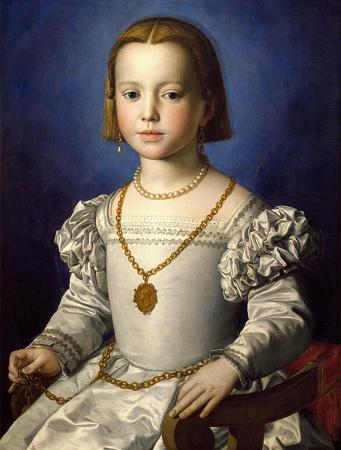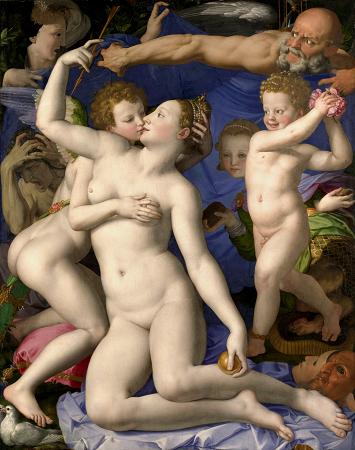Portrait of Bia de' Medici (c1542). Oil on panel. 63 x 48. The Portrait of Bia de' Medici is an oil-tempera on wood painting by Agnolo Bronzino, dating to around 1542 and now in the Uffizi in Florence. For a long time it was displayed in the Tribuna at the heart of the museum, but since 2012 it has been moved to the sale rosse of the Nuovi Uffizi. A second portrait, by Pontormo, has also been argued to show Bia de' Medici, but this identification is disputed. After her death, many art historians believe her father commissioned a posthumous painting of her by Agnolo Bronzino, which art historians regard as one of his finest works. The work is 63 cm by 48 cm and was painted in tempera on wood. In the famous painting, which is on display in the Galleria degli Uffizi in Florence, Bia wears a medallion with her father's profile on it, emphasizing her bond with her father. Bronzino shows the child half-length and sitting on a chair, recalling the pose in his slightly earlier Portrait of Lucrezia Panciatichi-a rigid official pose offset by some hints of hand movement, as if the character was about to get up, along with an intense but emotionless gaze straight at the viewer. The face is lit and highlighted by the blue background, whilst the cold light and absence of any strong chiaroscuro effect accentuates the smoothness of the subject's complexion and idealises her features. Her complexion is a pale white because Bronzino painted the portrait using her death mask as a model. Bia has her hair parted in the middle of her forehead and a falling bob, with two carefully tied braids framing the face. She wears pearl earrings, a gold chain with a pendant or medallion with her father's profile on it, emphasizing her bond with her father. She also wears a sumptuous dress, made of blue satin with puffy sleeves, produced in the silk factories Cosimo was setting up in Florence at the time. With her right hand she is fiddling with the end or tassel of a golden chain or belt around her waist. It was not an official state portrait, but would have hung in the family's private rooms as a reminder to them of the dead child and an inspiration and guide on the path to salvation. As art historian Gabrielle Langdon argues, Bronzino painted the child with a halo effect, in light-emitting white satin and pearls as a metaphor for both her nameBianca, which means white and her childish innocence. Like 'Laura,' the posthumous Bia is a riveting emanation from Heaven who bestows purifying grace on the beholder, Langdon wrote in the 2004 collection The Cultural World of Eleanora Di Toledo. Maike Vogt-Luerssen argues that the famous painting actually depicts Bia's younger, legitimate half sister, Maria de' Medici. Vogt-Luerssen noted in an article in Medicea-Rivista interdisciplinare di studi medicei that the subject of the portrait was identified as Maria until the 1950s and the pearls depicted in the portrait were a common symbol of the Medicis, often worn by legitimate female members of the house. Vogt-Luerssen believes that the child depicted in a famous portrait by Pontormo with Maria Salviati is actually Bia, her eldest granddaughter, because group portraits in that era depicted family members with close blood relationships and Salviati's two younger granddaughters, Maria and Isabella, were too young at Salviati's death to be the 5-or 6-year-old girl in the portrait. Regardless of which Medici daughter it depicts, the painting has continued to inspire modern artists. American sculptor Joseph Cornell's 1948 sculpture Medici Princess incorporates Bronzino's portrait of the girl. The sculpture, one of a series depicting members of the Medici family, shows an enameled reproduction of Bronzino's portrait in a dark wooden box, behind a blurred, deep blue glass pane. On either side of the main portrait are smaller vignette reproductions of the same portrait, behind glass as well. Below the girl's image, in a pull-out drawer, are a feather and a floor plan of the palace in Florence that was once her home. The sculpture, which is owned by a private collector, was on display during a recent retrospective of Cornell's work originating with the Smithsonian American Art Museum. Bianca de' Medici, usually known as Bia de' Medici, was the illegitimate daughter of Cosimo I de' Medici, Grand Duke of Tuscany, born before his first marriage. The identity of Bia's mother is not known, but Cosimo I was likely no older than sixteen when he fathered her. According to Edgcumbe Staley's The Tragedies of the Medici, some stories said the girl's mother was a village girl from Trebbio, where the Medicis had built one of their first villas, while others said she was a gentlewoman from Florence.
more...



